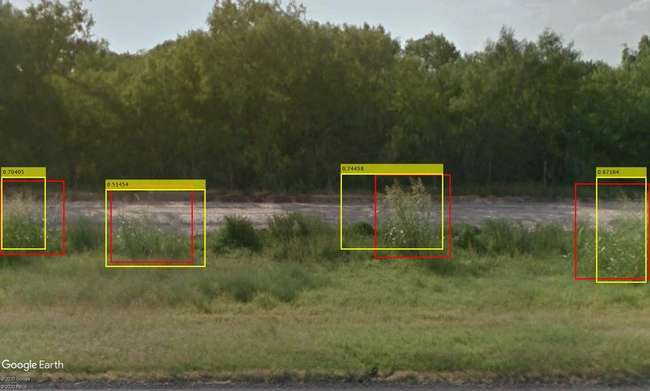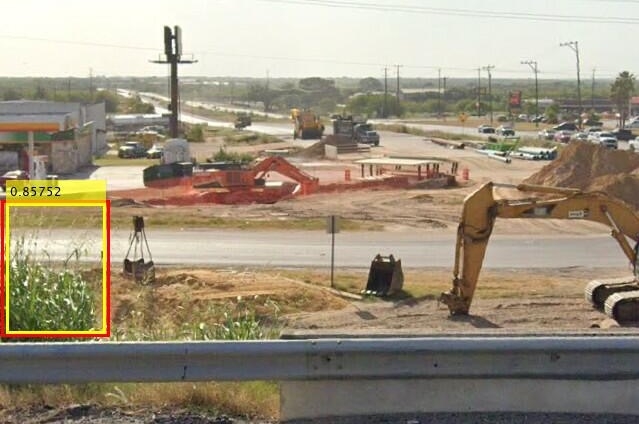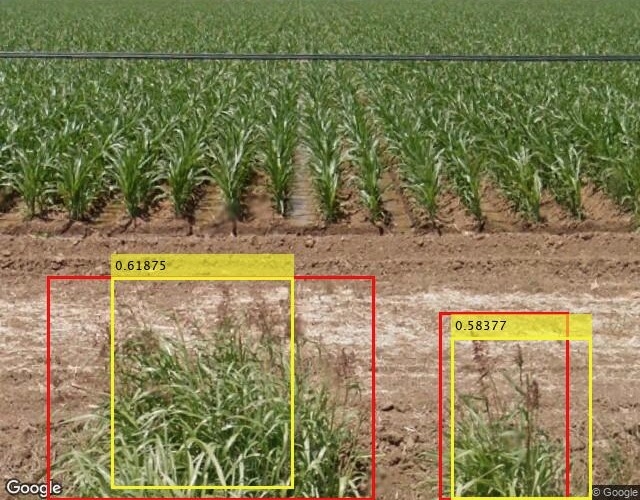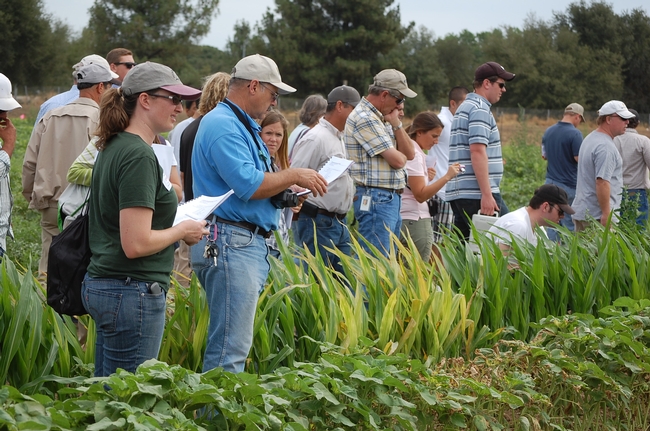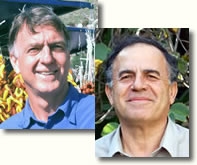Posts Tagged: Kassim Al-Khatib
Google Weed View? Professor trains computer to spot invasive weed
Algorithm for AI enables low-cost tracking of invasive plant
To manage johnsongrass, a noxious weed that crowds out cotton and sickens horses, farmers have tried herbicides, burning and hand-pulling. Now, researchers at University of California, Davis, have developed a more high-tech weapon against the invasive weed: artificial intelligence and machine learning.
Using photos from Google's Street View database, UC Davis researchers have tracked down over 2,000 cases of johnsongrass in the Western United States for a fraction of the cost and time that it would take to do drive-by or other in-person surveys. They call their tool Google Weed View.
The advancement could help land managers easily and quickly survey for other problem plants.
“Once the model is trained, you can just go and run it on millions of images from Google Street View,” said Mohsen Mesgaran, an assistant professor in the Department of Plant Sciences at UC Davis. “We have huge flexibility, and its capability can be scaled up very quickly.”
The technique can easily be extended to other plant species. All that is needed is to label the new item in Street View photos and train the algorithm to identify that object in the images.
By providing location information, Google Weed View also offers an opportunity to examine how climate affects the growth and spread of weeds and invasive plants at very large scales.
“I think it can be both useful for management and for people with interests in more basic questions in ecology,” Mesgaran said.
A colleague's query
Mesgaran began looking at using Google's photo database of roadways, streets and highways after Kassim Al-Khatib, a professor of Cooperative Extension in the same department, asked if he could survey Western states for johnsongrass.
Al-Khatib studies where johnsongrass grows, ways to manage it and how this perennial has evolved to be so prevalent and resilient. He's also working with scientists at the University of Georgia to decode the genome of johnsongrass, which is one of the top 10 most invasive weeds worldwide.
Johnsongrass can crowd out native plants, harbor pathogens and affect agriculture. It grows up to 7 feet tall with flowers that are green, violet, dark red or purplish brown depending on maturity, according to a UC Statewide Integrated Pest Management Program briefing page.
“Johnsongrass is a major weed not just in California but worldwide,” Al-Khatib said. “It's very difficult to control. It's a problem on vineyards. It's a problem for cultivated crops. It's a problem on orchards.”
Google Weed View allows for rapid, convenient scanning. It is continuously updated via everyday users with compatible cameras and images collected by Google. “Instead of a day of in-person driving, we can use AI to determine if johnsongrass is in a county or not,” Al-Khatib said.
Setting the parameters
To find the weeds, Mesgaran went to Google Street View, which hosts billions of panoramic photos. It didn't take long to find johnsongrass.
“The pictures are really good quality,” he said. “You can see plants and flowers.”
Street View's photos offer a 360-degree view, so in his request Mesgaran set parameters, based on street direction (bearing), to only see the side view. He also specified latitude and longitude, and other factors. To train the deep, or machine learning model, he chose Texas, where johnsongrass is prevalent.
A student sorted through over 20,000 images from that request to find pictures with johnsongrass and drew rectangular shapes around the weeds. They located 1,000 images.
The labeled photos were fed into a computer to train a deep learning algorithm capable of identifying johnsongrass in Google's images. The model was run again to capture potentially more images containing johnsongrass. These additional images were then labeled and used to further refine the model. With each iteration, the algorithm learned and became more accurate.
“This deep learning model was trained by these images,” Mesgaran said. “Once we had a semi-working model, we ran it against about 300,000 images.”
For Al-Khatib's request, researchers focused on 84,000 miles of main roads in California, Nevada, Oregon and Washington states. The team discovered 2,000 locations with johnsongrass.
Google Weed View cost less than $2,000 to purchase the images and teach the model. A traditional car survey to cover the same area would cost an estimated $40,000 in gas, hotel, food and other costs.
“In a matter of months, we came up with 2,000 records and I can do it for the whole U.S.,” Mesgaran said.
Next up? The entire United States.
This story was originally published on the UC Davis College of Agricultural and Environmental Sciences news site.
Root out weed problems with upcoming courses at UC Davis
Weeds are a pervasive and expensive problem in California. They can choke waterways, crowd out native species on rangeland, and rob farmers of crop yields. According to the California Invasive Plant Council, the annual cost of invasive plant work in California is at least $82 million.
The University of California has robust educational resources to help those engaged in the battle, and this summer UC Davis and UC Agriculture and Natural Resources personnel are offering a trio of programs to help in the effort.
Weed Day: July 7, 2016
The 60th annual Weed Day will be held at UC Davis on July 7 from 8 a.m. to 4:30 p.m. The program gets under way in the Buehler Alumni Center.
Weed Day will be of interest to pest control advisers, chemical company cooperators, faculty, students and regulatory officials. It is an opportunity to learn about the latest research and to visit current weed-control field trials. The event begins with a bus tour to the research plots. Following lunch, staff and students will present information on projects that are either not in-season or located too far off campus for viewing.
“We have tomatoes, walnuts, and almonds, as well as aquatic research results, and a weed identification quiz,” said professor and UC Cooperative Extension specialist Kassim Al-Khatib, chair of this year's event. “We'll be hearing about control of medusahead, management in grapes, a new herbicide for rice, and many studies on herbicide resistance issues.”
For additional information and to register.
Diagnosing Herbicide Symptoms: July 8, 2016
The Weed Research and Information Center at UC Davis is offering a new course, Diagnosing Herbicide Symptoms, on July 8 at the Bowley Plant Science Teaching Center.
This program will be of interest to pest control advisers, chemical companies, field investigators and insurance adjusters. The course focuses on how an herbicide injury situation can arise, what information can help diagnose herbicide problems during field investigations, and what tools are available.
Topics include herbicide modes of action, symptom development, recovery from herbicide injury, economic damage, and other areas. Instruction takes place in a lecture, field visit, and hands-on demonstrations. Course instructors include UC Cooperative Extension (UCCE) specialists Kassim Al-Khatib and Brad Hanson, UCCE farm advisor John Roncoroni, and Napa County Agricultural Commissioner Greg Clark.
For additional information and to register.
Aquatic Weed School: Sept. 7–8, 2016
The Aquatic Weed School will be held Sept. 7–8 at the Bowley Plant Science Teaching Center.
This intensive course is designed for those involved in consulting, research and management of aquatic weed systems throughout the western United States. Topics include ecological classification and impacts of aquatic weeds, biology of aquatic weeds, physical and chemical characteristics of aquatic ecosystems, regulatory issues, developing an aquatic management plan, aquatic weed identification, equipment demonstration, adjuvants and surfactants for aquatic systems, pest prevention for aquatic weeds, physical and mechanical control methods, biological control, chemical and non-chemical control, and a case study of a complex management plan.
For additional information and to register.
Need more information? Contact Gale Pérez with the UC Weed Research and Information Center, (530) 752-1748, gperez@ucdavis.edu.
Two UC scientists named weed science fellows
Two UC Davis weed scientists - Kassim Al-Khatib and Joe DiTomaso - have received the Weed Science Society of America's highest recognition. They were presented the "Fellow Award" at the society's annual gathering this week in Portland, Ore.
In all, nearly nearly two dozen individuals from academia, government and private industry were recognized for their outstanding contributions to the field of weed science, according to a WSSA news release distributed yesterday.
“These are true innovators who are making a significant mark on our profession through their research, teaching, publishing, outreach and development of new best practices,” said John Jachetta, the outgoing president of WSSA.
The news release detailed Al-Khatib and DiTomaso's contributions as follows:
- Kassim Al-Khatib, director of the Integrated Pest Management Program and a professor of weed science at the University of California. His specialty is weed physiology and herbicide resistance. Al-Khatib has led significant grant programs, holds two patents and has authored or co-authored nearly 350 refereed journal articles, abstracts and proceedings, extension and research publications and book chapters.
- Joseph DiTomaso, an invasive plants specialist who is director of the Weed Research and Information Center and cooperative extension specialist in the Department of Plant Sciences, University of California, Davis. He has delivered more than 750 extension presentations and has published more than 110 peer-reviewed papers and three books. He is currently president of the Western Society of Weed Science and is editor of the journal, Invasive Plant Science and Management.

